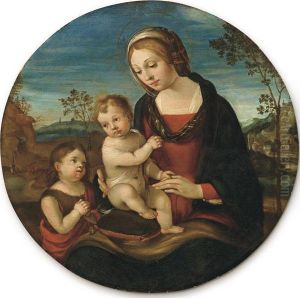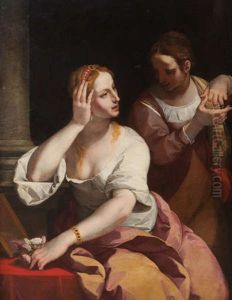Vincenzo Rustici Paintings
Vincenzo Rustici, an Italian painter, was born in 1556 in Siena, a city renowned for its rich artistic tradition during the Renaissance. He was a significant figure in the late Mannerist style, which was characterized by elongated forms and complex composition, bridging the transition towards the more naturalistic and emotionally expressive Baroque period. Rustici's work is deeply embedded in the artistic environment of Siena, where he was influenced by the local painters and the prevailing Sienese style, which often emphasized intricate decorative elements and a preference for vibrant colors.
Rustici came from a family involved in the arts; his father Cristoforo Rustici was also a painter, ensuring that Vincenzo was immersed in the artistic culture from a young age. He was notably influenced by the works of Domenico Beccafumi and Baldassare Peruzzi, two eminent Sienese artists whose styles and techniques left a lasting imprint on his artistic development. Throughout his career, Rustici specialized in religious subjects, contributing frescoes and altarpieces to many churches in Siena and its surrounding areas. His works are characterized by their dynamic compositions, the dramatic use of light and shadow, and the emotional intensity of the figures depicted.
Rustici's contribution to the Sienese school of painting was significant, particularly in maintaining the city's artistic legacy during a period of transition in Italian art. Despite the overshadowing prominence of Florence and Rome in the art historical narrative, artists like Rustici ensured that Siena remained a vibrant center for artistic production. His legacy is preserved in the city's churches and the Pinacoteca Nazionale di Siena, where his works continue to be studied and admired for their contribution to the late Renaissance and early Baroque periods.
Vincenzo Rustici passed away in 1632, leaving behind a body of work that reflects the transition of Italian art from the Mannerist to the early Baroque style. His paintings, with their deeply religious themes and innovative use of light, not only exemplify the artistic trends of his time but also contribute to the broader understanding of the period's cultural and spiritual concerns. Through his art, Rustici remains an important figure in the study of Italian Renaissance and its aftermath, illustrating the enduring appeal of Sienese painting and its impact on the development of European art.











